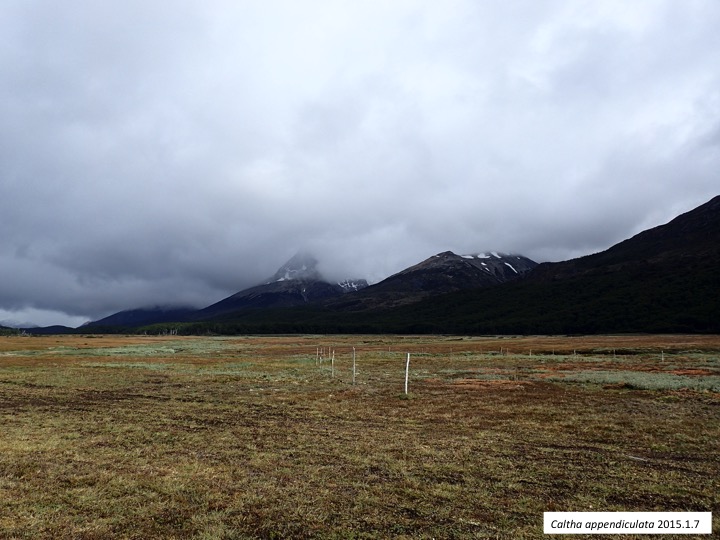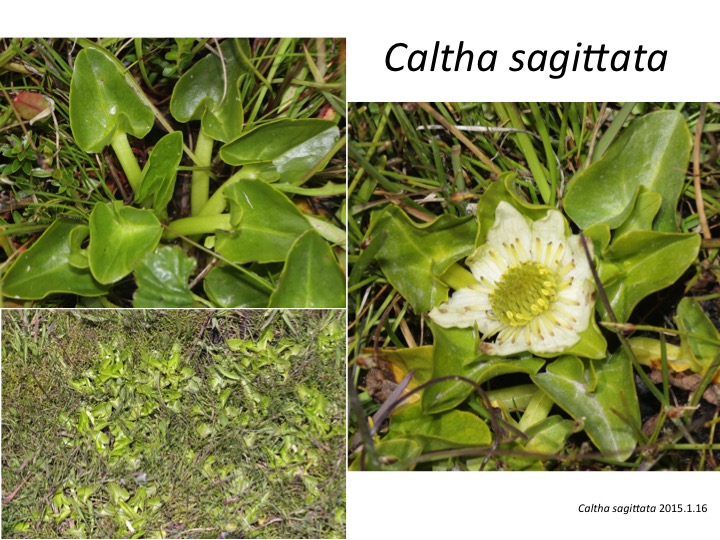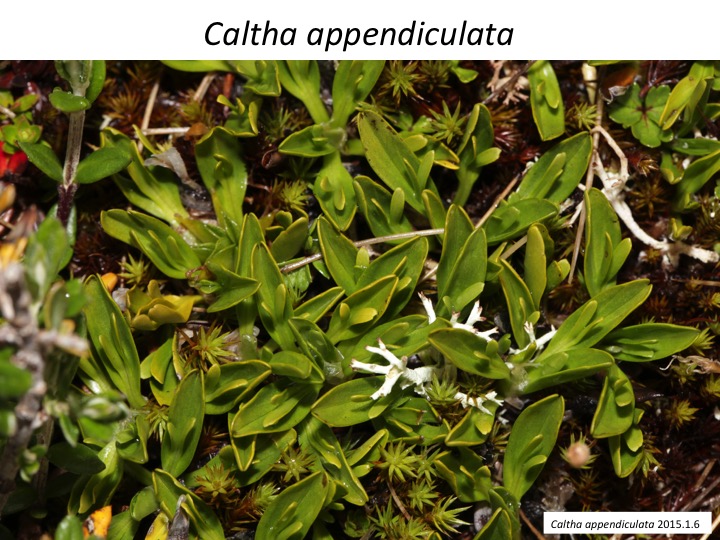Caltha sagittataはアンデス山脈南部といくつかの隔離された集団が南米北部から知られている(Schuettpelz and Hoot 2004)。
Caltha sagittata is mainly distributed in southern Andes and some local populations were found in northern South America.
Schuettpelz, E. and Hoot, S.B. 2004. Phylogeny and biogeography of Caltha (Ranunculaceae) based on chloroplast and nuclear DNA sequences. Amer. J. Bot. 91: 247-253.
Caltha sagittataのチリ、プンタアレナス周辺の自生地。
A locality of Caltha sagittata in Punta Arenas, Chile.
耳状の葉脚が曲がって突起になっている。この突起は表側が向かい合わせになるように折りたたまれ、重複葉diplophyllyと呼ばれる。気孔は葉の両面にできるが、裏側にはほとんどない (Hill 1918)。
Two inflexed appendages are formed by two auricles at the base of a leaf blade. Young leaves are vernated to face adaxial sides of appendages and lamina, called diplophylly. Stomata are formed on both sides but stomata on the abaxial side are few.
突起と葉身のつなぎ目の組織は葉縁の組織に似ている。もしかすると葉裂片が葉身と癒合したものかもしれない。しかし、リュウキンカ属で複葉を形成するものは無いので発生過程などを調べる必要がある。
Connected tissue between appendages and the lamina looks similar to a leaf margin. This may suggest that two leaf lobes are fused with a lamina at the base, although neither species of Caltha form compound leaves.
Caltha appendiculataは南米南端部に自生する。
Caltha appendiculata is distributed in southernmost parts of South America.
Caltha appendiculataのアルゼンチン、ウスアイアの自生地。
A locality of Caltha appendiculata in Ushuaia, Argentine.
二つの突起が葉身の基部から1/3位のところに形成される。葉の向軸側、突起の葉身側のみ気孔ができる (Hill 1918)。
Two appendages are formed at the one third distal positions of a lamina. Stomata are formed only on the adaxial side of a lamina and appendages..
向軸側が向かい合うように配列する。突起基部が葉身に癒合したように見える。
Adaxial surfaces are faces each other. Basal parts of appendages look to be fused on the lamina.
突起を1つだけ付ける個体。この個体の全ての葉に1つしか突起が無いことから、この形質は遺伝的なものかもしれない。
An individual with one appendage. All leaves of this individual form one appendages, suggesting this is inherited.
1枚の突起があるか、全く突起を形成しない個体。
An individual with one appendage or no appendage.
葉身が切れこむもの。
Individuals with a lobed lamina.
重複葉が切れこんでいる株。
Influx appendages are lobed.
3つの突起ができる個体。
An individual with three appendages.

Caltha dionaeifoliaは南米南端部に自生する。
Caltha dionaeifolia is distributed in southernmost parts of South America.
 Caltha dionaeifoliaはハエトリソウDionaea muscipulaに一見似ていることからこの名が付いた。しかし、Joel (1985)が走査型電子顕微鏡観察を行い、葉の表面に消化腺や吸収腺が無いことから、食虫植物ではないことを示した。 気孔は葉身の向軸側と突起の葉身側のみ形成される (Hill 1918)。
Caltha dionaeifoliaはハエトリソウDionaea muscipulaに一見似ていることからこの名が付いた。しかし、Joel (1985)が走査型電子顕微鏡観察を行い、葉の表面に消化腺や吸収腺が無いことから、食虫植物ではないことを示した。 気孔は葉身の向軸側と突起の葉身側のみ形成される (Hill 1918)。
Caltha dionaeifolia is named after Dionaea muscipula, because of the morphological similarity. However, Joel (1985) observed the surface structure and showed that Caltha dionaeifolia is not carnivorous because of the lack of digestive and absorptive glands. Stomata are formed on the adaxial side of a lamina and appendages.
Joel, D.M. F.L.S. 1985. Leaf anatomy of Caltha dionaeifolia Hooker (Ranunculaceae) – is this species carnivorous? Bot. J. Linn. Soc. 90: 243-252.









